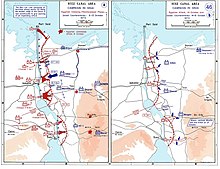The Battle of the Sinai was one of the most consequential battles of the Yom Kippur war. An Egyptian attacking force that advanced beyond their line of defense at the Bar-Lev Line was repulsed with heavy losses by Israeli forces. This prompted the Israelis to launch Operation Abiray-Lev (Stouthearted Men) the next day, penetrating the Egyptian line of defense and crossing the Suez Canal.
| Battle of the Sinai | |||||||
|---|---|---|---|---|---|---|---|
| Part of the Yom Kippur War | |||||||
 sinai war maps 1973 | |||||||
| |||||||
| Belligerents | |||||||
|
|
| ||||||
| Commanders and leaders | |||||||
|
Albert Mandler † Chaim Bar-Lev Abraham Adan Ariel Sharon Moshe Dayan |
Saad El Shazly Saad Mamoun Abdul Munim Wassel[1] Ahmad Ismail Ali | ||||||
| Strength | |||||||
|
800–900 tanks 60,000 soldiers[2][3] |
400 tanks 5,000 soldiers | ||||||
| Casualties and losses | |||||||
|
50–150 tanks destroyed[4][3] 60 other armored vehicles destroyed some aircraft shot down[5] 656 killed and wounded[6] |
200–264 tanks destroyed/captured[7] ~1,000 killed and wounded (Israeli estimate) | ||||||
Background
After Egyptian infantry had successfully crossed the canal and captured the Bar-Lev Line on October 6, Israeli forces made several counterattacks in attempts to push the Egyptians back across the Suez Canal. The Israelis suffered heavy losses in these attacks, and by October 9 Egyptian forces in the Sinai had managed to destroy 500 Israeli tanks.[8] Following this both sides dug in. The Egyptians would not attack for fear of extending their forces beyond the cover of their SAM defences.
In the Golan Heights, Israel had repelled Syrian forces and pushed into Syria itself. By the time the Syrians, now aided by Iraqi and Jordanian expeditionary forces managed to put a halt to the Israeli advance, Israeli forces were 40 km from Damascus. Syrian president Hafez Al-Assad requested his Egyptian ally, Anwar El-Sadat, order an attack in the Sinai, which would draw Israeli attention away from the Syrian front. Sadat consented and ordered the attack. His war minister, Ahmed Ismail, and his chief of staff, Saad El Shazly, opposed the idea; Shazli in particular stated that for Egyptian forces to advance outside their SAM defences would mean their exposure to the Israeli Air Force, which the Egyptian Air Force was too weak to challenge. Sadat insisted that the attack proceed, however, and both Ahmed Ismail and Shazli had no choice but to acknowledge the order.[9][10]
Prelude
The attack was to proceed on October 13, but was postponed to October 14. Four armored brigades and one mechanized infantry brigade under the command of the Second and Third Armies were to make four independent thrusts. Awaiting for them was a dug-in force of 800 Israeli tanks supported by infantry equipped with SS.11 missiles, as well as American-made LAW and TOW anti-tank missiles. Israel had in the Sinai by October 14 around fifteen brigades totaling nearly 60,000 infantry. The Israeli air force provided intense air cover during the battle.[2][7]
Battle and aftermath
The Egyptians launched their offensive in the early morning of October 14, at 6:30. The mechanized infantry brigade was to attack in the direction of the Gidi Pass, one armored brigade was to attack in the direction of the Mitla Pass, one brigade was to attack towards Baluza, and two brigades were to attack in the direction of Tasa. As anticipated by many Egyptian officers, the attack was a failure. Encountering stiff Israeli resistance, the Egyptian assault came to a halt after suffering heavy losses, and Egyptian troops retreated back to their lines on the Suez Canal.[11]
Egyptian losses in the battle were 200–250 tanks and up to 1,000 men killed and wounded in action. The 3rd Egyptian Armored Division was completely eliminated and 120 Egyptian prisoners were taken in the battle at Wadi Mab'uk. The Egyptians also lost their Second Army Commander, Saad Mamoun, who suffered a heart attack at the beginning of the day. By contrast, Israeli losses were 50–150 tanks, 60 other armored vehicles and some aircraft. The following day, the Israelis launched Operation Abiray-Lev, crossing the Suez Canal and cutting off the Egyptian Third Army's supply lines.[2][4][7]
References
- ^ Shazly The Crossing of the Suez p.161
- ^ a b c A Critical Review of the 1973 Arab-Israeli War Archived January 16, 2009, at the Wayback Machine
- ^ a b Shazly The Crossing of the Suez p.248
- ^ a b "Operational Valiant: Turning Of The Tide In The Sinai 1973 Arab-Israeli War". www.globalsecurity.org.
- ^ O'Ballance, Edgar (November 1996) [1978]. No Victor, No Vanquished: the Yom Kippur War. Presidio Press.
- ^ Staff, HistoryNet (August 21, 2006). "Yom Kippur War: Embattled Israeli Bridgehead at Chinese Farm". HistoryNet.
- ^ a b c Dr. George W. Gawrych The 1973 Arab-Israeli War: The Albatross of Decisive Victory Archived February 25, 2009, at the Wayback Machine p.56–57
- ^ October 9, 1973 conversation (8:20–8:40 am) between Israeli Ambassador to the United States Simcha Dinitz, military attaché General Mordechai Gur, Henry Kissinger, Brent Scowcroft, and Peter Rodman. Transcript George Washington University National Security Archive
- ^ Shazly The Crossing of the Suez p.245–248
- ^ El Gammasy The October War p.264–265
- ^ El Gammasy The October War p.277